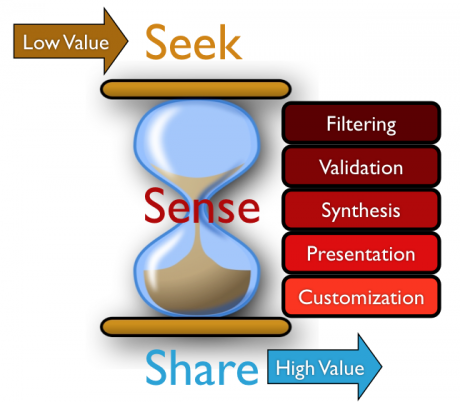
On December 17 at 6:30 pm, I am facilitating a discussion and presenting at one of Scoop.It’s “Lean Content” events in San Francisco. The topic is “The Unanticipated Benefits of Content Curation for Nonprofits.” Content curation is sifting through information on the web and organizing, filtering and making sense of it and sharing the very best content with your network. Rather than another potential recipe for information overload, content curation can be a method for self-directed learning that builds your expertise while enhancing your organization’s brand and content strategy. Content curation can empower us to learn more and use that knowledge to get deeper impact for our nonprofit’s programs. We can no longer afford to get distracted by the volume of information flying past us. Instead, content curation helps us keep focused.
While I have been doing content curation for the past twenty years that I’ve worked as a technology trainer, in July, 2011 I discovered the Scoop.It platform and started following and learning from some of best curators on the planet and in particular, Robin Good. As part of this learning journey, I stumbled across Harold Jarche’s “Seek Sense Share” framework for networked learning and started to apply it to my own self-directed learning which was happening through content curation. Recently, Robin highlighted an article by Jarche titled, “Ask What Value You Can Add” on Social Media Today.
Content curation is not about sharing links as you find them. It is finding great stuff amid the noise, annotating it, organizing it, and adding your wisdom or perspective and sharing a collection of curated links in a context or time that adds value. Jarche describes some techniques on how to do the most important, but sometimes difficult step of sense-making. Sense-making is the ability to determine the deeper meaning or significance of what is being expressed – and in a world with so much information, it is a critical workplace skill.
Jarche mentions some techniques from three different curators on how to add value. As Robin points it, this is a terrific checklist for the curator’s work flow.
Ross Dawson’s Five ways of Adding Value
- Filtering: Identifying groups of good sources or key words – so you can laser in on the topic
- Validation: Knowing your sources and their level of expertise
- Synthesis: Combining ideas and themes or boiling down a lot of information into a summary
- Presentation: Putting resources together – the ordering, sub-categories, and aesthetics
- Customization: Changing the title, context, or revising some of the ideas to match your audience’s needs
Jarche also points to James Mangan who identified several skills for acquiring knowledge in 1936 (via Maria Popova)
- Practice and experiment: Read the article and try the technique and describe how it worked or didn’t for you
- Answer the question yourself: Answer the question raised in the article from your own experience
- Change your perspective: Describe the article or resource from a different perspective
Robin Good picked up on the theme of sense-making, and identified five more techniques to help sharpen your sense-making skills as part of your content curation skill set.
- Comparing: Compare the strengths and weaknesses of different sources
- Finding related items: Search and find other sources or articles that are talking about the same idea, putting the resource into a different context
- Illustrating / Visualizing: Add an illustration to the resource or collection
- Evaluating: Rate and rank items in your collection
- Crediting & Attributing: Giving credit to the original source
I would add another way to add or get value and that is join the conversation in the comments of follow curators and ask them your questions. This is where I have learned valuable lessons about content curation, for example, by participating in the comments.
I think adding value is also about using your critical thinking skills. It made me wonder whether there were some useful ideas in the literature about teaching critical thinking skills that could be applied to content curation. Critical thinking is the process we use to reflect on, access and judge the assumptions underlying our ideas or other people’s ideas.
In 1993, noted American psychologist and expert on critical thinking R.W. Paul published Critical Thinking: How to Prepare Students for a Rapidly World. In his book, he outlines six types of Socratic questions that can develop critical thinking skills in students. If a curator is interested in adding value in the sense-making process, it would require asking these questions while analyzing a resource to add to a collection and how to present it:
- Clarification: How can the information be explained in another way? Is it accurate? It is well organized? Is it missing something?
- Assumptions: What are the writer’s assumptions? Can we verify or disapprove the assumption?
- Reasons and Evidence: What are some other examples of this idea? Is the same as something else?
- Viewpoints and Perspectives: What is another way to look at this idea? Is it the best? Why or why not? What are the strengths and weaknesses? What would be an alternative? What is the counter argument?
- Implications and Consequences: What generalization can or can’t be made? How does this tie into what I already know about the topic?
- Questions about Questions: Why is x important? What does this mean?
The biggest challenge with sense-making is that it requires hitting the pause button and thinking and reflecting, rather than getting caught in the forward rush of information flying past you. Also, it does take more time and in our sector we are often resource poor. But developing your sense-making skills and the ability to do it in less time is like exercising a muscle. The key is making a habit in the way that we seek out and share information on the Internet and social web.
How do make sense of information you curate?
